
NEVADA KING INTERCEPTS 1.11 G/T AUEQ OVER 25M AT SILVER PARK AND CONFIRMS NEW DISTRICT-SCALE POTENTIAL FOR ATLANTA-STYLE MINERALIZATION

Nevada King Gold Corp. (TSX-V: NKG) (OTCQB: NKGFF) is pleased to provide an update on its Phase III regional drill program including results from 25 reverse-circulation drill holes from its Silver Park target, at its 12,000 hectare (120km2), 100% owned Atlanta Gold Mine Project, located in the prolific Battle Mountain Trend 264km northeast of Las Vegas, Nevada. Silver Park is a large target area (3km E-W x 1km N-S), located ~2km from the Atlanta Resource Zone, that is centred on the historical Silver Park Mine, which was operational at a small scale through the turn of the 20th century (Figure 2).
Silver Park Highlights:
- Drilling at Silver Park has identified a strong geological and geochemical connection with the Atlanta Resource Zone (“ARZ”), demonstrating that both areas are part of the same mineralizing hydrothermal event. Gold and silver mineralization occur within the same host rocks and at the same stratigraphic position within the Atlanta Caldera volcanic sequence.
- The Company now sees strong evidence that the mineralized unconformity that acts as the primary gold control at Atlanta begins to shallow about 500m west of the ARZ where it comes back towards surface, flattens out, and continues into the Silver Park Target (Figure 1). Drilling over a 3km east-west area at Silver Park has encountered this unconformity, associated with the same intrusive bodies responsible for depositing gold and silver at the ARZ.
- This discovery marks a major departure from the prior understanding of Silver Park as a distinct geological environment, possessing only supergene (at-surface) mineralization with limited potential. Today’s discovery opens a large and untested domain (far larger than the ARZ itself) that could be host to another Atlanta-type deposit.
- Twelve of today’s holes encountered elevated and oxidized gold, silver, and associated arsenic values over a 3km east-west area. Highlight hole AT25SP-21 encountered 1.11 g/t AuEq over 25m, which is part of a 165m interval consisting of three separate mineralized horizons starting at just 18m depth that taken together average 0.47 g/t AuEq over 92m. AT25SP-21 is located 2km southwest of the Atlanta pit and represents the most significant mineralized interval ever drilled at Atlanta outside of the ARZ. Au-Ag mineralization observed in AT25SP-21 is very similar to that in the resource zone, although it occurs at a considerably shallower depth than most of the mineralization within the ARZ.
- Follow-up drilling is planned to further define near-surface, oxidized gold-silver zones at both Silver Park East and West, targeting additional mineralization, including stepping out north of AT25SP-21 into a large, untested CSAMT anomaly.
- Click here to watch a video discussing today’s results and the significance of hole AT25SP-21.
| Hole No. | From (m) | To (m) | Interval (m) | Au (g/t) | Ag (g/t) | AuEq* (g/t) | As (ppm) |
| AT25SP-021 | 18.3 | 48.8 | 30.5 | 0.20 | <0.50 | 0.20 | 660 |
| And | 97.5 | 121.9 | 24.4 | 0.164 | 94.8 | 1.11 | 183 |
| And | 146.3 | 182.9 | 36.6 | 0.071 | 20.3 | 0.27 | 169 |
| Table 1. Highlight hole released today from Silver Park East in both g/t Au and AuEq. Arsenic (As) is strongly associated with mineralization in the Atlanta District; understanding the spatial distribution of these elements can assist in vectoring towards areas with higher probability of mineralization. AuEq based on spot prices of US$3,310/oz Au and US$33.20/oz Ag |
Cal Herron, Exploration Manager of Nevada King, stated, “Silver Park has always been of interest historically, but very shallow mineralization and a very high silver-to-gold ratio led many to believe the mineralization was purely supergene and of little significance. Our new Phase III drilling has changed that view entirely.
“We’ve now confirmed strong gold and silver mineralization across a large area at Silver Park, including the 92m intercept grading 0.47 g/t AuEq in hole SP-21 — the first potentially economic discovery outside the Atlanta resource zone. This mineralization occurs along the same Tertiary-Paleozoic unconformity that hosts gold at Atlanta, and is associated with identical volcanic intrusives, but at a shallower depth.
“This drilling has also established direct geological and geochemical links between Silver Park and Atlanta tying mineralization in both areas to the same hydrothermal event. With this genetic tie now demonstrated, we have a powerful exploration model based on stratigraphy and lithochemistry that allows us to rapidly vector toward new targets across the caldera.
“After several years of work, we are seeing our understanding of the district come into clear focus, significantly increasing the odds of making new discoveries outside the current Atlanta resource.”
Additional Details
- Looking at the connection between Silver Park and Atlanta, Au/Ag mineralization in both areas occurs within the same host rocks and at the same stratigraphic position within the Atlanta Caldera volcanic sequence, which in turn strongly suggests mineralization in both areas is tied to the same hydrothermal system. This is evident in the long cross section (Figure 4) connecting Silver Park West with the ARZ. The Atlanta Rhyodacite hosts most of the gold mineralization within the ARZ and is chemically very similar to the Silver Park Rhyodacite that hosts mineralization in AT24SP-1, and AT25SP-9, AT25SP-10, and upper part of AT25SP-21.
- Furthermore, both mineralized rhyodacite units are underlain by a rhyolite horizon labeled the Lower Rhyolite in Figure 4 and Silver Park Rhyolite Tuff in Figures 5 and 6. These rhyolite units are chemically identical and occur directly on top of the Tertiary-Paleozoic unconformity and are therefore considered to be the same unit. These relationships now establish a district-scale tie between both areas with respect to Au/Ag mineralization, which is a key factor when assessing the district-scale potential for finding another Atlanta-style deposit.
- So far, the Company has tapped into two areas of shallow, oxidized Au/Ag mineralization at Silver Park (Silver Park East and Silver Park West) and is in the process of drill-evaluating other parts of the caldera, including following up on encouraging drill intercepts. A full explanation of drill results and targets at Silver Park East and Silver Park West is provided below.
Silver Park West Highlights:
- Silver Park West covers approximately 2km east to west and 1km north to south and has been identified by the initial stages of the Phase III drilling program. Broad zones of anomalous Au mineralization were intersected in numerous drill holes within volcanic tuff exhibiting heavy oxidation and clay alteration. This includes holes AT24SP-1 (0.093 g/t Au over 115.8m), AT25SP-9 (0.044 g/t Au over 140.2m), and AT25SP-10 (0.054 g/t Au over 129.2m) (Figure 5).
- Mineralization in all three holes starts at surface and is hosted in the Silver Park Rhyodacite unit around a mushroom-shaped rhyolitic dome (Figures 5 and 6). Average arsenic values range from 100ppm to 200ppm, and gold mineralization is evenly distributed throughout a thick, weakly silicified-argillized tuffaceous host rock. All drilling at Atlanta so far indicates this large, low-grade, blanket-like mineralization is highly unusual and is most likely derived from a nearby hydrothermal fluid source.
- With these three holes, the Company has found a large body of low-grade gold and now must vector in on higher concentrations of mineralization. New holes are planned northwest of AT24SP-1 along the structural trend and are currently in the permitting process, including testing a series of down-dropped graben blocks heading west and northwest that are indicated by the CSAMT data.
- A vertical hole recently completed between AT24SP-1 and AT25SP-9 revealed the presence of two northerly-trending faults immediately west of Silver Park that display progressive, westward down-drop offsets on the silicified unconformity (see AT25SP-27 on Figure 6, assays pending). This structural pattern is spatially related to shallow, rhyolitic intrusions and associated gold mineralization observed within the volcanic section as well as along the unconformity and is like the structure and mineralization patterns observed at the ARZ. The SPW target appears similar to the West Atlanta Graben Zone in terms of its geologic setting. The low-grade gold halo seen in the Silver Park holes so far measures approximately 600m by 700m in area, which means the Company has a significant amount of exploratory drilling to complete to hone in on higher-grade structures like those seen in the ARZ.
- The western margin of the SPW target area is covered by post-mineral volcanic rocks erupted from the Ryan Springs Caldera. Surface geochemistry at the SPW target shows elevated As, Sb, and Mo signatures in soils directly bordering the volcanic cover with strong indication these anomalies could continue beneath cover. Au and Ag mineralization around Silver Park is similar to the style of zonation found outside the ARZ, showing potential for another Atlanta-style deposit to be found around SPW.
Silver Park East Highlights:
- The Silver Park East target measures 1,500m east-west by 1,000m north-south and is bounded on the east and west sides by northerly-trending faults and on the north side by a thick moat sequence that fills the center of the Atlanta Caldera. The target remains open to the south where post-mineral Ryan Springs volcanics obscure the Atlanta caldera’s southern margin. Throughout the target, gold and silver mineralization occurs along the Tertiary-Paleozoic unconformity, in overlying volcanics proximal to shallow rhyolitic intrusions, and in dolomite beneath the unconformity. The close association between shallow intrusions and down-faulted grabens with Au/Ag mineralization mimics what is seen in the ARZ. Mineralization has so far been found in two areas: one located at the target’s northern end where CSAMT anomalies indicate potential for mineralization similar to the North Extension portion of the ARZ, and the other located at the southern end where historical workings and a historical drill hole revealed shallow mineralization along intrusive contacts.
- Highlight hole AT25SP-21 is located at the southwestern corner of a flat-lying, roughly rectangular shaped CSAMT anomaly that extends 500m north by 600m east and remains undrilled. A similar sized, flat-lying CSAMT anomaly coincides with the North Extension portion of the ARZ, where replacement-type mineralization also occurs along the Tertiary-Paleozoic unconformity. It was this similarity in CSAMT anomalies that prompted siting AT25SP-21. The mode of gold mineralization in both areas is strikingly similar, but unlike the North Extension part of the resource zone, gold also occurs in AT25SP-21 above and below the unconformity in volcanics and dolomite, respectively. We see this same type of Au occurrence above and below the unconformity in several other Silver Park holes, which is more akin to gold occurrences found in the central Atlanta resource area.
- The Company drilled two vertical, Phase III holes into the CSAMT anomaly to test its western and eastern ends. The western hole, AT25SP-21, encountered: 0.20g/t Au over 30.5m starting at 18.3m depth; 0.164 g/t Au and 94.8 g/t Ag over 24.4m starting at 97.5m depth; and 0.071 g/t Au and 20.3 g/t Ag over 36.6m starting at 146.3m. The shallow gold intercept occurs within altered tuff, and the high-grade Ag interval occurs at the volcanic-dolomite unconformity, while the deeper Ag interval occurs within variably altered dolomite. The three mineralized intervals show low gold grades, but they are thick and relatively shallow, plus the mineralization is oxidized and evenly distributed within each interval, (Figure 6). This hole not only contains mineralization that is potentially economic, but more importantly, it verifies strong mineralization within the large CSAMT anomaly. The Company now intends to trace this mineralization to the north, south, and east. New holes and travel routes are currently being permitted with the BLM.
- Hole AT25SP-23 was drilled on the eastern side of the northern CSAMT anomaly, testing a major fault inferred from the air-magnetics and CSAMT datasets (Figure 3). The hole encountered 0.223 g/t Au over 6.1m starting at 54.8m and 0.125g/t Au over 24.4m starting at 109.7m and reveals an eastward continuation of mineralization within the volcanic sequence and along the Tertiary-Paleozoic unconformity. This portion of the property is completely covered by the same Ryan Springs post-mineral volcanic sequence that also covers the ARZ. Additional holes have been planned to push the drilling further eastward and northward in search of high-grade structures potentially hiding beneath the Ryan Springs cover. This is the same exercise that Nevada King completed in 2022-2024, as it drilled westward from the Atlanta pit area, chasing mineralization down into the WAGZ.
- Historical drilling within the SPE target generally returned poor results, but Goldfields RC hole AR-70 tested a target 200m northwest of AT25SP-21 intersecting 4.7m of 0.2 g/t Au in volcanics above the unconformity and a long intercept of strong Ag mineralization at 13.61 g/t Ag over 62.4m in the underlying dolomite, (Table 3). The results indicate this shallow, low-grade mineralization in altered volcanics and underlying dolomite in AR-70 can be correlated over 200m to the same gold/silver occurrences in AT25SP-21, thus demonstrating continuity in grade and thickness at relatively shallow depths within the SPE Target. Further exploration will continue to determine the potential for continued broad mineralization within the target area, more importantly, investigating any occurrence of higher-grade material.
Silver Park Lineament
The Silver Park Lineament is a major structural corridor identified by geophysical interpretation of gravity, drone magnetics, and CSAMT, as well as intrusive-related mineralization at surface. It is within this northwesterly-trending corridor that the majority of Tertiary intrusive rocks observed at Atlanta cut upward through basement rocks at fault intersections (Figures 7 and 8). The corridor extends approximately 7km from the historic Bradshaw mine at the south end of Atlanta South to the west-northwest, approximately 3km past SPW, and is rooted in Paleozoic basement rock (Figure 9). CSAMT data indicate multiple NS structures cutting through the target areas as well as oblique crossing structures, and it is at the intersection of these structures where numerous rock chip samples running over 2+ g/t Au and up to 4.58 g/t Au have been found, some of the highest Au grade samples on the property outside of the resource area. In conjunction with rock samples and field observations, soil sampling from early Nevada King work shows strong correlation of Au, Ag, As, weak Mo, and Sb signatures along the lineament (Figure 7).
| Hole No. | From (m) | To (m) | Interval (m) | Au (g/t) | Ag (g/t) | As ppm |
| AT24SP-001* | 12.2 | 128.0 | 115.8 | 0.093 | <0.10 | 141 |
| Includes | 103.6 | 128.0 | 24.4 | 0.23 | 0.73 | 178 |
| AT24SP-002 | 250 | 277.3 | 27.3 | 0.004 | <0.10 | 60 |
| AT24SP-003* | NSI | NSI | NSI | NSI | NSI | NSI |
| AT24SP-004 | NSI | NSI | NSI | NSI | NSI | NSI |
| AT24SP-005 | 67.0 | 146.3 | 79.3 | 0.056 | 1.3 | 136 |
| AT25SP-006 | 164.6 | 195.1 | 30.5 | 0.119 | 4.0 | 340 |
| AT25SP-007 | 42.7 | 79.2 | 36.5 | 0.028 | <0.10 | 128 |
| AT25SP-009* | 0 | 140.2 | 140.2 | 0.044 | <0.10 | 86 |
| And | 213.3 | 274.3 | 61.0 | 0.088 | 0.60 | 140 |
| AT25SP-010* | 0.0 | 129.2 | 129.0 | 0.054 | <0.10 | 119.7 |
| Includes | 48.8 | 61.0 | 12.2 | 0.254 | <0.10 | 333 |
| AT25SP-011 | 24.4 | 128.0 | 103.6 | 0.032 | 3.1 | 41 |
| AT25SP-012 | NSI | NSI | NSI | NSI | NSI | NSI |
| AT25SP-013* | 0 | 109.7 | 109.7 | 0.059 | 1.6 | 231 |
| AT25SP-016 | 6.1 | 73.1 | 67.0 | 0.061 | 1.2 | 267 |
| AT25SP-017 | 42.7 | 91.4 | 48.7 | 0.040 | 1.2 | 72 |
| AT25SP-018 | 134.1 | 146.3 | 12.2 | 0.613 | 0.7 | 151 |
| Includes | 134.1 | 140.2 | 6.1 | 1.08 | 0.5 | 180 |
| And | 249.9 | 262.1 | 12.2 | 0.066 | 1.0 | 411 |
| AT25SP-019 | NSI | NSI | NSI | NSI | NSI | NSI |
| AT25SP-020 | 54.9 | 67.1 | 12.2 | 0.184 | <0.10 | 383 |
| And | 262.1 | 268.2 | 6.1 | 0.50 | 5.3 | 202 |
| AT25SP-021 | 18.3 | 48.8 | 30.5 | 0.20 | <0.10 | 660 |
| And | 97.5 | 121.9 | 24.4 | 0.164 | 94.8 | 183 |
| And | 146.3 | 182.9 | 36.6 | 0.071 | 20.3 | 169 |
| AT25SP-022 | NSI | NSI | NSI | NSI | NSI | NSI |
| AT25SP-023 | 54.8 | 60.9 | 6.1 | 0.223 | 6.5 | 823 |
| And | 109.7 | 134.1 | 24.4 | 0.125 | 3.4 | 35 |
| AT25SP-024 | 128.0 | 134.1 | 6.1 | 0.347 | <0.10 | 104 |
| AT23WT-001 | 199.7 | 300.3 | 100.6 | 0.046 | 3.4 | 24 |
| AT23WT-002 | 187.5 | 237.8 | 50.3 | 0.047 | <0.10 | 59 |
| Includes | 189.0 | 195.1 | 6.1 | 0.187 | 4.3 | 238.3 |
| AT23WT-003+ | 182.9 | 259.1 | 76.2 | 0.067 | 10.4 | 34 |
| Includes | 186.0 | 214.9 | 29.0 | 0.124 | 24.7 | 52 |
| AT23WT-004 | 141.8 | 161.6 | 19.8 | 0.012 | 0.3 | 12 |
| AT24WT-005 | 239.3 | 266.7 | 27.4 | 0.056 | 6.5 | 53.2 |
| Includes | 239.3 | 242.3 | 3.0 | 0.260 | 14.0 | 207 |
| Table 2: All drill results in today’s release. * Denotes angled holes. + Denotes holes that bottomed in mineralization. Multielement geochemistry is used to understand trace elements most associated with different styles of mineralization. Arsenic (As) is strongly associated with mineralization in the Atlanta District. Understanding of the spatial distribution of these elements can assist in vectoring towards areas with higher probability of mineralization.
|
| Hole No. | From (m) | To (m) | Interval (m) | Au (g/t) | Ag (g/t) |
| AR-46 | 0 | 7.62 | 7.62 | 0.26 | 13.30 |
| AR-47* | 0 | 21.3 | 21.3 | 0.04 | 43.28 |
| AR-70+ | 22.7 | 27.4 | 4.7 | 0.22 | <0.50 |
| And | 29.0 | 91.4 | 62.4 | <0.10 | 13.61 |
| SP05-RC2*+ | 44.2 | 51.8 | 7.6 | 0.13 | 5.0 |
| And | 150.9 | 152.4 | 1.5 | 0.13 | 1.8 |
| SP05-RC3* | 36.6 | 45.7 | 9.1 | 0.39 | 1.7 |
| SP05-RC4* | 18.3 | 19.8 | 1.5 | 0.15 | 91.0 |
| SP05-RC7* | 30.5 | 35.1 | 4.6 | 0.30 | 76.0 |
| SP05-RC8*+ | 10.7 | 47.2 | 36.5 | 0.32 | 2.6 |
| AT24WS-86 | 323.2 | 353.7 | 30.5 | 1.35 | 4.0 |
| AT23ET-8 | 0 | 77.7 | 77.7 | <0.04 | <0.5 |
| AT21-71 | 0 | 42.7 | 42.7 | <0.30 | <0.5 |
| Table 3: Historic drill holes and previously released Nevada King holes used in today’s release. AR series holes were drilled by Goldfields in 1990. SP05 series holes were drilled by Northern Abitibi Gold Corp. in 2005. *Denotes angled holes. +Denotes hole that bottomed in mineralization. |
QA/QC Protocols
All RC samples from the Atlanta Project are split at the drill site and placed in cloth and plastic bags utilizing a nominal 2kg sample weight. CRF standards, blanks, and duplicates are inserted into the sample stream on-site on a one-in-twenty sample basis, meaning all three inserts are included in each 20-sample group. Samples are shipped by a local contractor in large sample shipping crates directly to American Assay Lab in Reno, Nevada, with full custody being maintained at all times. At American Assay Lab, samples were weighted then crushed to 75% passing 2mm and pulverized to 85% passing 75 microns to produce a 300g pulverized split. Prepared samples are initially run using a four acid + boric acid digestion process and conventional multi-element ICP-OES analysis. Gold assays are initially run using 30-gram samples by lead fire assay with an OES finish to a 0.003 ppm detection limit, with samples greater than 10 ppm finished gravimetrically. Every sample is also run through a cyanide leach for gold with an ICP-OES finish. The QA/QC procedure involves regular submission of Certified Analytical Standards and property-specific duplicates.
Qualified Person
The scientific and technical information in this news release has been reviewed and approved by Calvin R. Herron, P.Geo., who is a Qualified Person as defined by National Instrument 43-101.
About Nevada King Gold Corp.
Nevada King is focused on advancing and growing its 100% owned, past producing, 120km2 Atlanta Gold Mine project located along the Battle Mountain trend in southeast Nevada. The project hosts an NI 43-101 compliant pit-constrained oxide resource of 460,000 oz Au in the measured and indicated category (11.0M tonnes at 1.3 g/t) plus an inferred resource of 142,000 oz Au (5.3M tonnes at 0.83 g/t) based on historical drilling, and does not include any of the 100,000m+ of drilling completed by Nevada King. See the NI 43-101 Technical Report on Resources titled “Atlanta Property, Lincoln County, NV” with an effective date of October 6, 2020, and a report date of December 22, 2020, as prepared by Gustavson Associates and filed under the Company’s profile on SEDAR+ (www.sedarplus.ca).
NI 43-101 Mineral Resources at the Atlanta Mine
| Resource
Category |
Tonnes
(000’s) |
Au Grade
(ppm) |
Contained Au
(Oz) |
Ag Grade
(ppm) |
Contained Ag
(Oz) |
| Measured | 4,130 | 1.51 | 200,000 | 14.0 | 1,860,000 |
| Indicated | 6,910 | 1.17 | 260,000 | 10.6 | 2,360,000 |
| Measured + Indicated | 11,000 | 1.30 | 460,000 | 11.9 | 4,220,000 |
| Inferred | 5,310 | 0.83 | 142,000 | 7.3 | 1,240,000 |
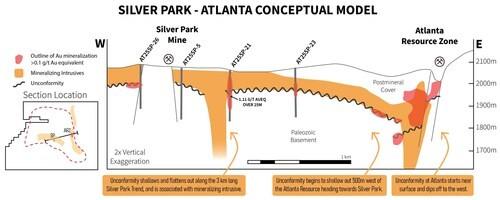
Figure 1. Simplified schematic of section R26, viewed from the north-northwest perspective, spanning 3km and connecting the Silver Park West and Silver Park East target areas with the Atlanta resource zone. The diagram illustrates the continuity along the basement unconformity from Silver Park (left) to the Atlanta Resource Zone (right), as well as the similar intrusions and their relationship with the unconformity that is responsible for mineralization at the ARZ. (CNW Group/Nevada King Gold Corp.)
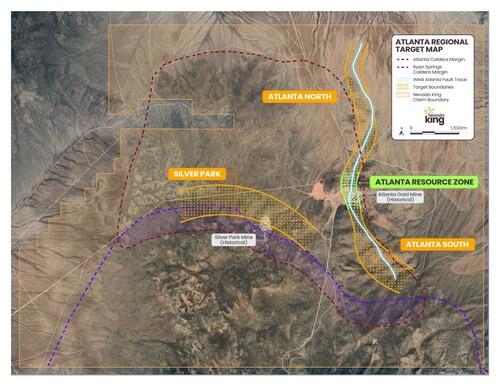
Figure 2. Plan view of Atlanta Gold Mine Project area with locations of the Silver Park, Atlanta South, and Atlanta North exploration targets in relation to the property boundary. Gold mineralization found to date is confined to the Atlanta Caldera, while the Ryan Springs Caldera is younger and obscures the southern portion of the Atlanta Caldera. (CNW Group/Nevada King Gold Corp.)
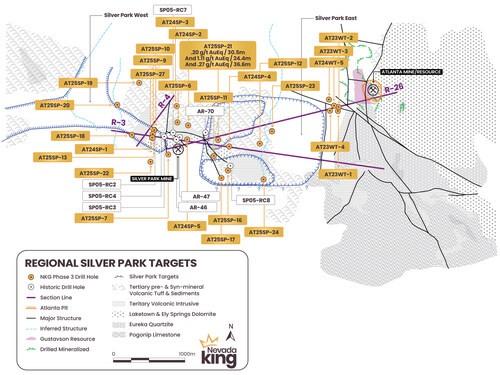
Figure 3. Simplified geologic map of the Silver Park West and Silver Park East regional targets in relation to the Atlanta pit and resource zone. Drill holes cited in the text and tables are shown together with cross section locations. Much of the district is covered by post-mineral volcanic sediments and ignimbrite flows derived from the Ryan Springs Caldera to the south. (CNW Group/Nevada King Gold Corp.)
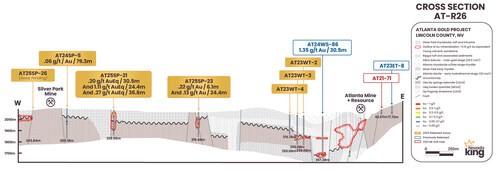
Figure 4. Section R-26 looking north-northwest at 3km span connecting the Silver Park West and Silver Park East target areas with the Atlanta Resource Zone. The historical Atlanta pit is at the far right. Gold mineralization at Atlanta is largely hosted within the Atlanta Rhyodacite intrusive dome, while mineralization at Silver Park West and East is hosted in the Silver Park Rhyodacite. Both units are chemically similar. (CNW Group/Nevada King Gold Corp.)
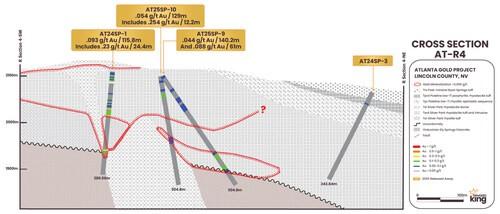
Figure 5. Cross section R4 looking obliquely to the northwest across the Silver Park West Target. Gold mineralization is hosted within the Silver Park Rhyodacite unit near a rhyodacite dome. Anomalous gold in rock and soil samples occurs northwest of this section in an area where CSAMT and gravity data indicate the presence of additional intrusive domes obscured by post-mineral volcanics and alluvium. Drilling is planned for this summer. (CNW Group/Nevada King Gold Corp.)
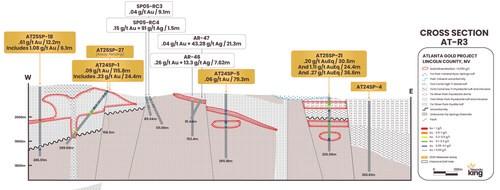
Figure 6: Cross section R3 looking north at the Silver Park West and Silver Park East Targets. Gold mineralization at Silver Park West occurs within weakly altered Silver Park Rhyodacite around the margin of a rhyodacite dome. Au-Ag mineralization at Silver Park East occurs above the Tertiary-Paleozoic unconformity in Silver Park Rhyodacite, it occurs at the unconformity, and also below the unconformity in dolomite. (CNW Group/Nevada King Gold Corp.)
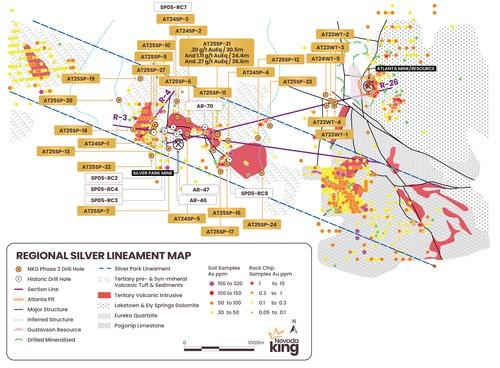
Figure 7. Plan view of the Silver Park Lineament (“SPL”) in relation to geology and anomalous geochemistry from rock and soil samples. The SPL was defined through geophysical interpretation of gravity, magnetic, and CSAMT data sets, although a strong NW trend can be seen in the alignment of outcropping basement rocks and rhyodacite domes/dikes. Post mineral volcanic cover obscures much of the prospective ground along the SPL. (CNW Group/Nevada King Gold Corp.)
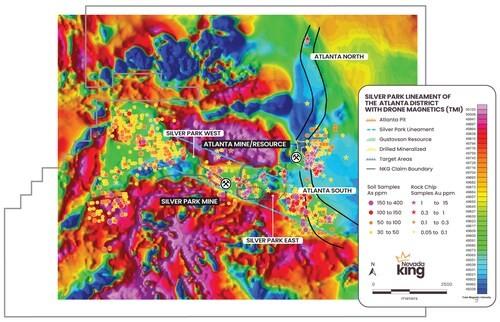
Figure 8. Plan view of the Atlanta district showing plot of total magnetic intensity in relation to Phase III targets, soil sample values, and location of the Silver Park Lineament. Hot colors indicate magnetic highs that generally correspond to volcanic and intrusive lithotypes, while cool colors denote magnetic lows that often coincide with Paleozoic basement rocks. (CNW Group/Nevada King Gold Corp.)
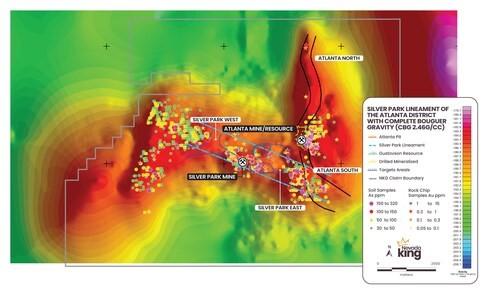
Figure 9. Plan view: Atlanta district – Bouguer gravity plot in relation to Phase III targets, soil sample values & location of SPL. Warm colors=high-gravity signatures from lithologies (eg Paleozoic basement rocks). Cooler colors=low-gravity lithologies (eg Tertiary volcanics & alluvium-filled valleys). SPL sits atop major high gravity corridor comprised of Paleozoic carbonates rocks & is bracketed to the north & south by volcanic moat sequences associated with Atlanta & Ryan Springs Calderas. (CNW Group/Nevada King Gold Corp.)
MORE or "UNCATEGORIZED"
Kuya Silver Confirms High-Grade Silver-Gold Vein Mineralization at Umm-Hadid with Initial Drill Results up to 1483.9 g/t AgEq over 2 Metres
Kuya Silver Corporation (CSE: KUYA) (OTCQB: KUYAF) (FSE: 6MR1) is... READ MORE
First Phosphate Closes Final Tranche of Oversubscribed Private Placement
First Phosphate Corp. (CSE: PHOS) (OTCQX: FRSPF) (FSE: KD0) is... READ MORE
GFG Receives Final Payment from the Sale of its Rattlesnake Hills Gold Project
GFG Resources Inc. (TSX-V: GFG) (OTCQB: GFGSF) announces that i... READ MORE
Goliath Receives $1,730,882 Through Warrant Exercises, Inclusive Of Crescat Capital A Longtime Strategic And Cornerstone Shareholder
Goliath Resources Limited (TSX-V: GOT) (OTCQB: GOTRF) (FSE: B4IF)... READ MORE
Robex Pours First Gold at Kiniéro on Schedule and Budget
Highlights: Gold bar weighing 2.64 kilograms (85 oz) poured in th... READ MORE












